Book contents
- Architectures of Earth System Governance
- Series page
- Architectures of Earth System Governance
- Copyright page
- Contents
- Contributors
- Acknowledgements
- 1 Architectures of Earth System Governance
- Part I The Building Blocks
- Part II Core Structural Features
- Part III Policy Responses
- 9 Policy Integration
- 10 Interplay Management
- 11 Orchestration
- 12 Governance through Global Goals
- 13 Hierarchization
- Part IV Future Directions
- Glossary
- Index
- References
12 - Governance through Global Goals
from Part III - Policy Responses
Published online by Cambridge University Press: 17 April 2020
- Architectures of Earth System Governance
- Series page
- Architectures of Earth System Governance
- Copyright page
- Contents
- Contributors
- Acknowledgements
- 1 Architectures of Earth System Governance
- Part I The Building Blocks
- Part II Core Structural Features
- Part III Policy Responses
- 9 Policy Integration
- 10 Interplay Management
- 11 Orchestration
- 12 Governance through Global Goals
- 13 Hierarchization
- Part IV Future Directions
- Glossary
- Index
- References
Summary
Governance through goals, a relatively new global governance mechanism, has recently gained prominence, particularly since the adoption of the Sustainable Development Goals. Through this mechanism, internationally agreed policy goals orchestrate the activities of governmental and non-governmental actors. This chapter argues that governance through goals has important effects on governance architectures and their degree and type of fragmentation. To analyze these effects, we review literature around four characteristics of governance through goals: their non-legally binding nature, weak global institutional arrangements, inclusive goal-setting processes and national leeway. We argue that alternative forms of bindingness, such as reporting and accountability mechanisms, can steer actors toward a shared vision. This may result in synergistic fragmentation if broad support is obtained through inclusive processes. However, tensions and cherry-picking may arise when goals are prioritized and implemented. Further research on the effects of governance through goals is crucial given that it is likely to maintain – and gain – importance in earth system governance.
Keywords
- Type
- Chapter
- Information
- Architectures of Earth System GovernanceInstitutional Complexity and Structural Transformation, pp. 254 - 274Publisher: Cambridge University PressPrint publication year: 2020
References
- 15
- Cited by



